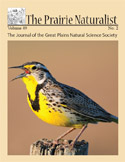Great Plains Natural Science Society

The Prairie Naturalist
Date of this Version
12-2011
Document Type
Article
Citation
The Prairie Naturalist 43(3/4): 132-133. December 2011
Abstract
Many scientists and educators agree that the goal of science education is to prepare students "to know, use and interpret scientific explanations of the natural world," as cited in the National Research Council publication, Taking Science to School: Learning and Teaching Science in Grades K-8 (DuschI et al. 2007). Yet, many science instructors of K-12 and post-secondary students often rely on teacher-telling modes of pedagogy and neglect to engage their students in natural inquiry and scientific study that model the research methods used by scientists. As a result, many young people are not aware of how scientists make discoveries about the natural world. Moreover, some critics argue that our children are so out of touch with the natural world that they prefer to be "plugged in" to electronic games rather than discovering the outdoors, a phenomenon coined as "nature deficit disorder" by Louv (2006). In response to the realization that our students need more meaningful science instruction, scientists and educators actively proposed reforms and have been studying the effects of various instructional and assessment strategies. As I read about the nature study movement in the late 1800s and early 1900s, I realized that for the past 100 years, North American educators have been passionate about the same things--trying. To find ways to improve science instruction by making It more relevant and interesting to students. We know that when people are passionate about topics, they are more motivated to learn, and this is exactly the sentiment that educators drew upon at the start of the nature study movement in the United States and Canada.
Included in
Biodiversity Commons, Botany Commons, Ecology and Evolutionary Biology Commons, Natural Resources and Conservation Commons, Systems Biology Commons, Weed Science Commons


Comments
Published by the Great Plains Natural Science Society, 2011. Used by permission.